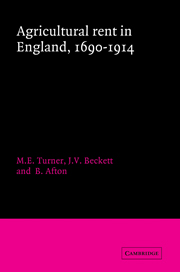Book contents
- Frontmatter
- Contents
- List of figures
- List of tables
- Preface
- Note on the text
- List of abbreviations
- Two examples of contemporary rent books
- Introduction
- 1 Agricultural rent in England
- 2 Contemporary views of rent in eighteenth and nineteenth-century England
- 3 The current state of knowledge
- 4 The determining parameters of a rent index
- 5 Constructing the rent index I: estate records
- 6 Constructing the rent index II: government inquiries
- 7 Constructing the rent index III: other studies
- 8 An English agricultural rent index, 1690–1914
- 9 Rent arrears and regional variations
- 10 The rent index and agricultural history I: the long term
- 11 The rent index and agricultural history II: the short term
- Conclusion
- Appendix 1 Sources of the rent index
- Appendix 2 Statistical summary
- Bibliography
- Index
3 - The current state of knowledge
Published online by Cambridge University Press: 02 December 2009
- Frontmatter
- Contents
- List of figures
- List of tables
- Preface
- Note on the text
- List of abbreviations
- Two examples of contemporary rent books
- Introduction
- 1 Agricultural rent in England
- 2 Contemporary views of rent in eighteenth and nineteenth-century England
- 3 The current state of knowledge
- 4 The determining parameters of a rent index
- 5 Constructing the rent index I: estate records
- 6 Constructing the rent index II: government inquiries
- 7 Constructing the rent index III: other studies
- 8 An English agricultural rent index, 1690–1914
- 9 Rent arrears and regional variations
- 10 The rent index and agricultural history I: the long term
- 11 The rent index and agricultural history II: the short term
- Conclusion
- Appendix 1 Sources of the rent index
- Appendix 2 Statistical summary
- Bibliography
- Index
Summary
Contemporaries knew relatively little about rents and there has inevitably been a knock-on effect for historians. Equally inevitably, historians have looked for ways of filling the gap in order to try to work out the trend in rents across time. In this chapter we look at the methods used to reconstruct the long-term pattern of agricultural rent, and in doing so we ask searching questions about the existing state of knowledge. Without much doubt modern agrarian historians know a great deal more about trends and patterns than Arthur Young, James Caird, and their contemporaries, but if we are to look with any certainty at the significance of rent for agricultural history, and for the economic history of industrialising England more generally, we need to be sure that our conclusions are anchored in rock and not in sand. To this end, we shall argue that modern attempts to reconstruct rental trends may have the parameters of the argument more or less right, within limits, but that a more systematic approach is required to ensure that we are building on reliable foundations which will not crumble.
Long-term trends
The starting point for any study of this nature must be the index of rents published thirty years ago by J. D. Chambers and G.E. Mingay and reproduced here as figure 3.1. Chambers and Mingay used guesstimates. They worked from a ‘small’ sample of rents, skewed towards the eighteenth century. On those grounds alone we have to be cautious about their findings because no attempt was made to collect data systematically, although there is no reason to believe that for this reason alone their work is seriously at fault.
- Type
- Chapter
- Information
- Agricultural Rent in England, 1690–1914 , pp. 50 - 69Publisher: Cambridge University PressPrint publication year: 1997

